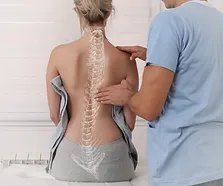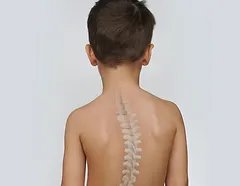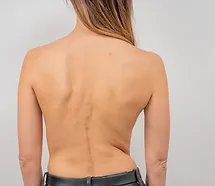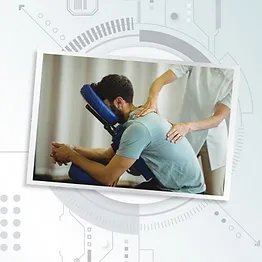Scoliosis
Pain Symptoms
Headache Symptoms
Shoulder & Neck Pain
Spine & Joints
- Disc-herniation
- Scoliosis
- Sciatica
- Back Pain
- Ankylosing Spondylitis
- Osteoporosis
- Pregnancy Pain
- Bone Spur
Upper Limbs
Lower Limbs
Scoliosis of the spine
Scoliosis is the abnormal side to side curvature of the spine. When viewed from behind, a normal spine should appear straight but the spine of a person suffering from scoliosis will show varying degrees of curvature. A person with scoliosis can have 1 or 2 curves to the spine, giving the appearance of either a "C" or "S" shaped spine.
Causes of Scoliosis:
- Congenital - caused by bony abnormality at birth
- Idiopathic - the most common type of scoliosis, idiopathic scoliosis appears during development with no known cause
- Degenerative - this can be the result of natural degenerative changes or traumatic injury to the spine
- Neuromuscular - the result of muscle or nerve abnormalities that can lead to imbalance of the spine.
Self-detection fact sheet
Cobb angle
- 10° - 20° :elevated shoulder; paraspinal muscle imbalance and tightness
- 20° - 40° :change of alignment of thoracic, with concave side muscle spasm
- > 40° :severe spinal mal-alignment; cardiopulmonary function would be affected if conditions get worse which is life-threatening



Facts about scoliosis in children every parent should know
A curve in the spine may get worse as your child grows, so it is important to find any problem early. Scoliosis most often causes no symptoms in your child until the spinal curve becomes large.
Simple examination
Parents can ask their child to lean forward with his or her feet together and bend 90 degrees at the waist. The examiner can then easily view from this angle any asymmetry of the trunk or any abnormal spinal curvatures.
You might also notice these early signs:
- Your child has one shoulder or hip that looks higher than the other.
- Your child's head does not look centered over the body.
- Your child has one shoulder blade that sticks out more than the other.
- Your child's waistline is flat on one side, or the ribs look higher on one side when your child bends forward at the waist.
Treatment and care
The goal of treatment for scoliosis is to prevent the spinal curve from getting worse and to correct or stabilize a severe spinal curve. The number of degrees helps the doctor decide what type of treatment is necessary. A scoliosis curves that are less than 20 degrees usually need to have regular checkups until pubertal maturation and growth are complete. If the curves are 20 to 40 degrees, the orthopedist will generally suggest a back brace. A Cobb angle of 40 degrees or more may mean that surgery is necessary.
- Surgical operation: with the advancement of internal fixation technique and biomechanics, the risk of operation is reduced. However, post-operation complications such as limited spinal movements, muscles atrophy, osteoporosis, osteophytes, etc. are still encountered.
- Physiotherapy: Stretching exercise, muscle strengthening exercise and breathing exercise assigned by physiotherapist would help reduce recurrence and minimize complications.
- Spine and Physiotherapy adjustment: Spine and Physiotherapist would correct the mal-aligned spine by means of biomechanical lever concepts.
- Back orthosis: Daily use can prevent scoliosis from fast-worsening
The earlier the scoliosis prevention and treatment, the higher the effectiveness
Scoliosis usually occurs in the growth during childhood or adolescence. Children in puberty can wear a brace to prevent further worsening of scoliosis as the child grows. Therefore, earlier treatment can better manage the scoliosis condition and slow down the progression. Many patients who delayed the treatment become more prone to other painful conditions after growing up. Their appearance may also be affected, which can certainly harm their mental health. Therefore, early diagnosis and treatment for sciatica are very important.
Scoliosis FAQ
What will worsen scoliosis?
Activities including backbends, gymnastics, high jump, dance (especially ballet) and some yoga poses will extend the thoracic spine backwards and further twist the vertebrae sideways. These movements often speed up scoliosis progression.
When will scoliosis stop progressing?
In most idiopathic scoliosis cases, the curve begins to develop when patients enter puberty. It continues to develop throughout the stage until the spine is fully grown (usually around the age of 16-18)
Will scoliosis correct itself?
As scoliosis is an incurable and progressive condition, it will neither go away nor heal itself without treatment.
What effects will scoliosis bring?
If scoliosis causes a severely twisted spine which compresses important organs, it may become life-threatening. Under this circumstance, surgery may be the best choice. If not treated in time, severe scoliosis may shorten one’s lifespan.



